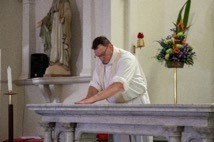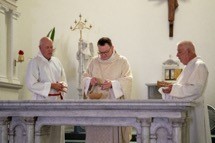 I remember when I was young travelling in Europe, my friends and I went searching for a Catholic Church one Saturday night. No apps to help you in those days. And it was Spain and no one understood us. It was the fourth Church we went into that was Catholic. How did we know the three previous Churches weren’t Catholic and the fourth one was? The layout of the Sanctuary! Specifically the prominence of the altar. For Catholics, within the context of the whole sanctuary, the significance of the altar marks our identity and shapes our prayer and life. You can see from the photo that our whole Chapel was destroyed. And while we blessed the Chapel, it was the altar and only the altar that we dedicated.
I remember when I was young travelling in Europe, my friends and I went searching for a Catholic Church one Saturday night. No apps to help you in those days. And it was Spain and no one understood us. It was the fourth Church we went into that was Catholic. How did we know the three previous Churches weren’t Catholic and the fourth one was? The layout of the Sanctuary! Specifically the prominence of the altar. For Catholics, within the context of the whole sanctuary, the significance of the altar marks our identity and shapes our prayer and life. You can see from the photo that our whole Chapel was destroyed. And while we blessed the Chapel, it was the altar and only the altar that we dedicated.
When we are looking to understand better some aspect of our faith, the first place to go to explore its meaning is the liturgy. So let’s reflect on the ‘Prayer of Dedication’ from Tuesday’s liturgy:
We glorify you, Lord, and we bless you,
for in the ineffable Sacrament of your love,
you have decreed that the mystery of the altar
should be brought to fulfilment in Christ,
to whom all types and shadows yield.
For Noah, the second father of the human race,
once the flood had receded,
set up an altar to you and offered a sacrifice,
which you, Father, accepted as a fragrant offering,
so renewing your covenant of love with the human race.
Abraham, our father in faith,
clinging to your word with all his heart,
constructed an altar,
so that, not sparing Isaac, his beloved son,
he might be pleasing to you.
Moses too, the mediator of the old Law,
built an altar,
which, sprinkled with the blood of a lamb,
would mystically prefigure the altar of the Cross.
All this, Christ has fulfilled in the Paschal Mystery:
for by ascending the tree of the Cross as Priest and Victim
he gave himself over to you, Father, as a pure oblation,
so that the sins of the whole world might be blotted out
and a new and eternal covenant be made with you.
Therefore, O Lord, we humbly beseech you:
pour forth from heaven
your sanctifying power upon this altar,
built in the house of the Church,
that it may be an altar dedicated for all time
by the sacrifice of Christ,
and stand as the Lord's table
where your people are refreshed by the divine banquet.
Let this stone, cut and shaped, be for us a sign of Christ,
from whose pierced side flowed blood and water,
by which were established the Sacraments of the Church.
Let this be a festive table,
to which the guests of Christ will hasten with joy,
so that, casting on you their cares and burdens,
they may gain new strength of spirit for new paths ahead.
Let it be the place of intimate communion with you
and a place of peace,
where those who feed on the Body and Blood of your Son
are filled with his Spirit and grow in your love.
Let it be the source of the Church's unity
and of fraternal harmony,
where your faithful, gathering as one,
drink of the spirit of mutual charity.
Let this altar be the place of our praise and thanksgiving
until we come jubilant to the eternal dwellings
where we are to offer you the sacrifice of unending praise
with Christ, the High Priest and living Altar.
Who lives and reigns with you in the unity of the Holy Spirit,
one God, for ever and ever.
What do you notice? What does this prayer help you know and understand about the mystery of the altar around which we gather? How is your reflection on the altar inviting you to deepen your participation in liturgy?
 Of course Catholic liturgy is embodied. It is far more than a series of prayers. In the celebration of the liturgy the meaning of the prayer is also revealed in the whole ritual experience. So what else did we do to dedicate the altar at Lochinvar? At the end of the Liturgy of the Word the Dedication began with the Litany through which we invoked the intercession of the saints in what we were about to do together. Then followed the Prayer of Dedication after which Fr. Andrew took off his chasuble and rolled up his sleeves to anoint the altar with the oil of Chrism. Liturgy is meant to be sensual and the anointing of the altar was indeed sensual as the fragrance of the Chrism filled the chapel and our imaginations were invited to consider all the anointing’s we have known, especially the anointing of Christ’s body in life and death, and our own anointing at baptism and confirmation. After the anointing a brazier was placed upon the altar and incense filled the air as Fr Andrew prayed:
Of course Catholic liturgy is embodied. It is far more than a series of prayers. In the celebration of the liturgy the meaning of the prayer is also revealed in the whole ritual experience. So what else did we do to dedicate the altar at Lochinvar? At the end of the Liturgy of the Word the Dedication began with the Litany through which we invoked the intercession of the saints in what we were about to do together. Then followed the Prayer of Dedication after which Fr. Andrew took off his chasuble and rolled up his sleeves to anoint the altar with the oil of Chrism. Liturgy is meant to be sensual and the anointing of the altar was indeed sensual as the fragrance of the Chrism filled the chapel and our imaginations were invited to consider all the anointing’s we have known, especially the anointing of Christ’s body in life and death, and our own anointing at baptism and confirmation. After the anointing a brazier was placed upon the altar and incense filled the air as Fr Andrew prayed:
Let our prayer rise, O Lord, in your sight;
and as this house is filled with a pleasing fragrance,
so let your Church be fragrant with the aroma of Christ.
And so the altar was dedicated, not by us, but through us, by Christ’s Paschal Mystery. And so dedicated, the next people to approach it bowed because now the altar is dedicated to Christ. Now it is a visible sign exp
ressing the mystery of Christ. Now it is the Lord’s table around which we gather to be changed: to be made holy, to be refreshed, to be strengthened to walk new paths. I was struck by how much the Prayer of Dedication talks about us – the Body of Christ.
This is why, once the liturgy begins, we bow to the altar. To bow to anything else during the liturgy doesn’t make sense. Nothing else in the sanctuary space is dedicated. Other things may be blessed, but they are not dedicated.
When done well the liturgy, because it is an action of Christ in and through his body the Church, proclaims our faith, shapes us in that faith and sends us forth on mission, fragrant with the aroma of Christ, to change the world.
We had a great day last Tuesday. I hope that liturgy continues to reverberate in me for a long time yet. Hopefully your reflection on this Prayer of Dedication might lead you to ponder the mystery of the altar the next time you gather for worship… how we are made holy, we are refreshed, we are renewed in strength, we are gathered into the communion of Christ’s peace and are filled with Christ’s Spirit so as to grow in Christ’s love. The world needs altars dedicated to Christ. And I need to gather round them regularly.